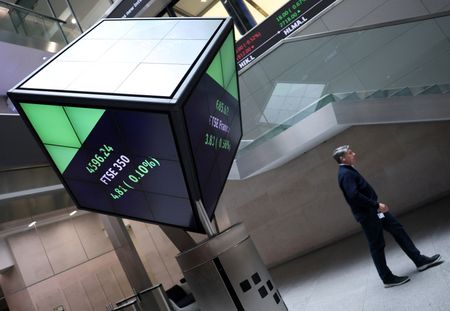By Chris Prentice and Amanda Cooper
NEW YORK/LONDON (Reuters) – The dollar fell and major U.S. stock indexes were mixed on Tuesday after data showed U.S. consumer inflation picked up less than expected in April when President Donald Trump unveiled a raft of tariffs that have wreaked havoc on global markets.
The U.S. and China on Monday said they would pause their trade war for 90 days, bringing down reciprocal duties and removing other measures while they negotiate a more permanent arrangement.
The agreement has reignited investor appetite for stocks, cryptocurrencies and commodities and Tuesday’s inflation figures helped power that move.
MSCI’s gauge of stocks across the globe rose 0.61%.
The Bureau of Labor Statistics said its consumer price index (CPI) rose 0.2% in April, bringing the annual increase down to 2.3% from 2.4%.
Economists polled by Reuters had forecast a monthly rise of 0.3% and a yearly rise of 2.4%.
The report was “good news”, Bill Adams, Chief Economist for Comerica Bank in Dallas, said in a note. “Inflation should be manageable for most consumers and businesses in 2025.”
On Wall Street, the Dow Jones Industrial Average fell 0.31% to 42,276.83, while the S&P 500 rose 0.71%, to 5,885.47 and the Nasdaq Composite gained 1.38%, to 18,966.09.
The dollar extended losses against a basket of currencies and was last down 0.29% as the euro rose by as much as 0.4% on the day to a session high of $1.113.
“The report basically indicates that the Fed needs to be very cautious and that the stand that they have taken is probably the right course, for now,” said Peter Cardillo, chief market economist at Spartan Capital in New York.
European shares were virtually steady with the pan-European STOXX 600 up 0.05%, and Europe’s broad FTSEurofirst 300 index up 0.03%.
Emerging market stocks fell 0.61%, to 1,154.75.
MSCI’s broadest index of Asia-Pacific shares outside Japan closed lower by 0.51% at 603.95, while Japan’s Nikkei rose 1.43%, to 38,183.26.
Following the Geneva talks at the weekend, the U.S. said it will cut tariffs imposed on Chinese imports to 30% from 145%, while China said it would cut duties on U.S. imports to 10% from 125%.
The shift in U.S.-China trade relations has led traders to reduce their expectations for Federal Reserve rate cuts, as they believe policymakers may have more leeway to lower rates if the risks to inflation abate.
Traders are now pricing in 56 basis points of cuts this year, down from forecasts for over 100 basis points in April, when fears about the impact of Trump’s tariffs were at their worst.
“The Fed has embarked on what seems to be the right course and unless there’s any real movements in terms of trade war ending by June, it looks like a June rate cut remains in question,” Cardillo said.
Economists, fund managers and analysts have said that while the 90-day pause is welcome, it has not changed the bigger picture.
“When all is said and done, tariffs will still be dramatically higher and will weigh on U.S. growth,” Christopher Hodge, chief U.S. economist at Natixis, said.
Ratings agency Fitch estimates the U.S. effective tariff rate is now 13.1%, a notable decline from 22.8% prior to the agreement but still at levels unseen since 1941 and above the 2.3% that prevailed at the end of 2024.
Meanwhile, the benchmark 10-year U.S. treasury yield rose 2.2 basis points to 4.479%, while the 2-year note yield, which typically moves in step with interest rate expectations for the Federal Reserve, fell 0.8 basis points to 3.994%,
In commodities, spot gold gained 0.31% to $3,243.73 an ounce and U.S. gold futures rose 0.29% to $3,229.40 an ounce.
Brent crude futures rose to $65.93 per barrel, up 1.49% on the day, as U.S. crude gained 1.74% to $63.03.
(Additional reporting by Stephen Culp in New York, Ankur Banerjee and Rocky Swift in Tokyo; Editing by Susan Fenton, Hugh Lawson and Tomasz Janowski)











